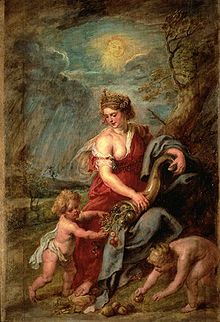- Abundantia
-
- For the Christian saint, see Saint Abundantia.
In ancient Roman religion, Abundantia (Latin pronunciation: [abʊnˈdantia]) was a divine personification of abundance and prosperity. She was among the embodiments of virtues in religious propaganda that cast the emperor as the ensurer of "Golden Age" conditions.[1] Abundantia thus figures in art, cult, and literature, but has little mythology as such. She may have survived in some form in Roman Gaul and medieval France.
Contents
In Rome
The Augustan poet Ovid gives Abundantia a role in the myth of Acheloüs the river god, one of whose horns was ripped from his forehead by Hercules. The horn was taken up by the Naiads and transformed into the cornucopia that was granted to Abundantia.[2] (Other aetiological myths provide different explanations of the cornucopia's origin.) On Neronian coinage, she was associated with Ceres and equated with Annona, who embodied the grain supply.[3] Like Annona, Abundantia was a "virtue in action" in such locations as the harbor, where grain entered the city.[4]
Abundantia occurs in the context of Mithraic iconography on a vase from Lezoux, in the Roman province of Gallia Aquitania, which presents the most complete depiction of the act of bull-slaying that was central to the religion. Abundantia is seated and holds a cornucopia as an image of "the abundance that stems from Mithras' act."[5]
Possible survivals
It has been suggested[6] that the Gallic goddess Rosmerta had a functional equivalence to Abundantia, but the two are never directly identified in inscriptions. William of Auvergne (d. 1249), a bishop of Paris, mentions a Domina Abundia (“Mistress Abundia”), who also appears in the Roman de la Rose as “Dame Habonde.” The bishop derives her name from abundantia, but he may be in error. At night the dominae enter houses where offerings have been set out for them. They eat and drink from the vessels, but the contents are undiminished.[7] If they are pleased, they bring prosperity and fertility. William regarded these practices as a form of idolatry.[8] Folklorists of the 19th century saw these figures as Celtic fairies.[9]
Nicholas of Cusa reports that on his travels through the French Alps in 1457, he met two old women who told him they were in the service of Domina Abundia. They identified themselves as apostate Christians, and had been imprisoned for witchcraft. Nicholas felt that they had been deluded by the devil, but should be allowed to receive penance rather than burning at the stake.[10]
Later art and allegory
In later Western art Abundantia is often portrayed holding her cornucopia and sheaves of corn or wheat.[11]
See also
- Fortuna
- Tyche
References
- ^ J. Rufus Fears, "The Cult of Virtues and Roman Imperial Ideology," Aufstieg und Niedergang der römischen Welt II.17.2 (1981), p. 812.
- ^ Ovid, Metamorphoses; 9.87–88, as cited by Fears, p. 821.
- ^ Fears, "The Cult of Virtues," p. 897.
- ^ Fears, "The Cult of Virtues," p. 913.
- ^ Manfred Claus, The Roman Cult of Mithras: The God and His Mysteries, translated by Richard Gordon (Routledge, 2000, originally published 1990 in German), p. 118.
- ^ Paul-Marie Duval, "Rosmerta," American, African, and Old European Mythologies (University of Chicago Press, 1993), p. 221.
- ^ Edward Burnett Tylor, excerpt from Primitive Culture, in Understanding Religious Sacrifice: A Reader (Continuum, 2003, 2006), p. 22.
- ^ Alan E. Bernstein, "The Ghostly Troop and the Battle over Death: William of Auvergne (d. 1249)," Rethinking Ghosts in World Religions (Brill, 2009), p. 144.
- ^ Benjamin Thorpe, Northern Mythology (London, 1861), vol. 1, p. 281; Jacob Grimm, Teutonic Mythology (English translation London, 1880), pp. 283–288.
- ^ Hans Peter Broedel, The Malleus Maleficarum and the Construction of Witchcraft: Theology and Popular Belief (Manchester University Press, 2003), p. 109.
- ^ Jürg Meyer zur Capellen, Raphael: The Roman Religious Paintings, ca. 1508-1520 (Arcos, 2005), p. 264.
Categories:- Roman mythology
- Roman goddesses
- Fortune goddesses
- French folklore
- Characters of European folklore
Wikimedia Foundation. 2010.

